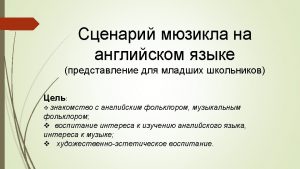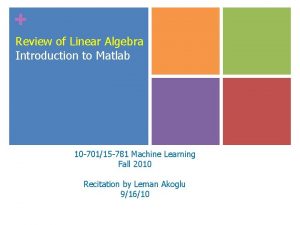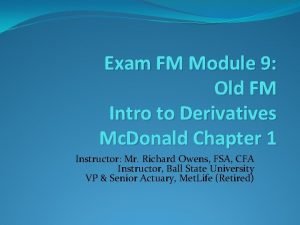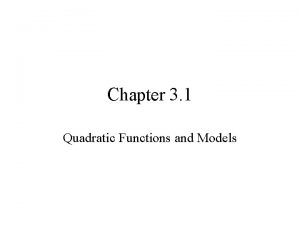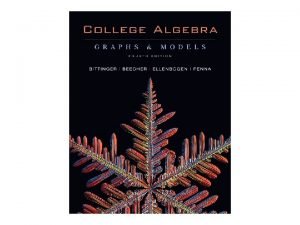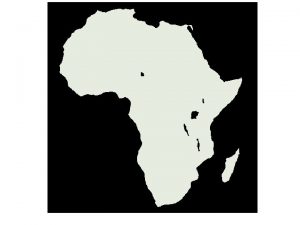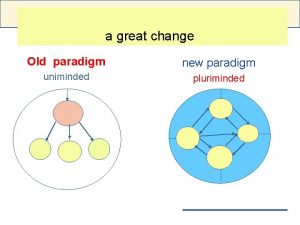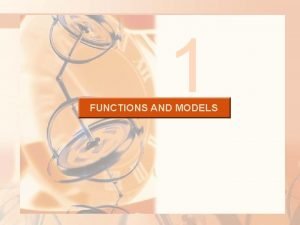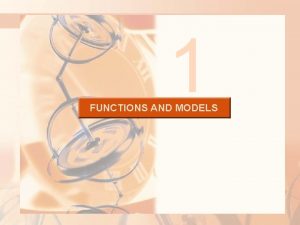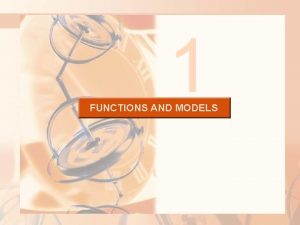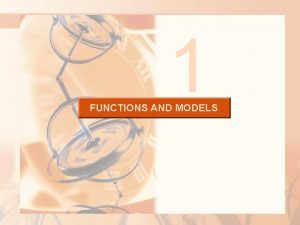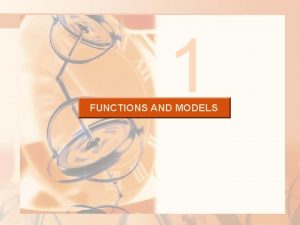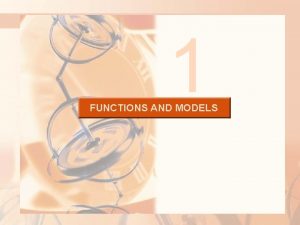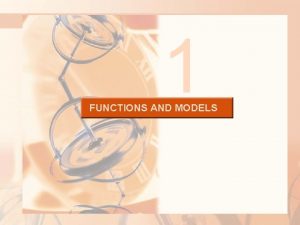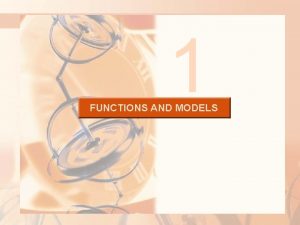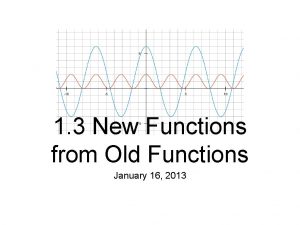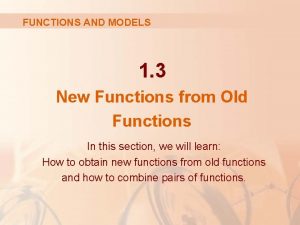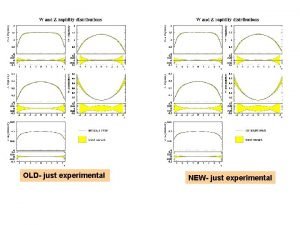1 NEW FUNCTIONS FROM OLD FUNCTIONS AND MODELS

























- Slides: 25

1 NEW FUNCTIONS FROM OLD

FUNCTIONS AND MODELS 1. 3 New Functions from Old Functions In this section, we will learn: How to obtain new functions from old functions and how to combine pairs of functions.

COMBINATIONS OF FUNCTIONS Two functions f and g can be combined to form new functions f + g, f - g, fg, and in a manner similar to the way we add, subtract, multiply, and divide real numbers.

SUM AND DIFFERENCE The sum and difference functions are defined by: (f + g)x = f(x) + g(x) (f – g)x = f(x) – g(x) § If the domain of f is A and the domain of g is B, then the domain of f + g is the intersection. § This is because both f(x) and g(x) have to be defined.

SUM AND DIFFERENCE For example, the domain of is and the domain of is. So, the domain of is.

PRODUCT AND QUOTIENT Similarly, the product and quotient functions are defined by: § The domain of fg is. § However, we can’t divide by 0. § So, the domain of f/g is

PRODUCT AND QUOTIENT For instance, if f(x) = x 2 and g(x) = x - 1, then the domain of the rational function is , or

COMBINATIONS There is another way of combining two functions to obtain a new function. § For example, suppose that and § Since y is a function of u and u is, in turn, a function of x, it follows that y is ultimately a function of x. § We compute this by substitution:

COMBINATIONS This procedure is called composition— because the new function is composed of the two given functions f and g.

COMPOSITION In general, given any two functions f and g, we start with a number x in the domain of g and find its image g(x). § If this number g(x) is in the domain of f, then we can calculate the value of f(g(x)). § The result is a new function h(x) = f(g(x)) obtained by substituting g into f. § It is called the composition (or composite) of f and g. § It is denoted by (“f circle g”).

COMPOSITION Definition Given two functions f and g, the composite function (also called the composition of f and g) is defined by:

COMPOSITION The domain of is the set of all x in the domain of g such that g(x) is in the domain of f. § In other words, is defined whenever both g(x) and f(g(x)) are defined.

COMPOSITION The figure shows how to picture in terms of machines.

COMPOSITION Example 6 If f(x) = x 2 and g(x) = x - 3, find the composite functions and § We have: .

COMPOSITION Note You can see from Example 6 that, in general, . § Remember, the notation means that, first, the function g is applied and, then, f is applied. § In Example 6, is the function that first subtracts 3 and then squares; is the function that first squares and then subtracts 3.

COMPOSITION Example 7 If and , find each function and its domain. a. b. c. d.

COMPOSITION § The domain of Example 7 a is:

COMPOSITION Example 7 b § For to be defined, we must have , that is, , or. § Thus, we have. § So, the domain of is the closed interval [0, 4].

COMPOSITION § The domain of Example 7 c is .

COMPOSITION Example 7 d § This expression is defined when both. § The first inequality means. § The second is equivalent to , or or. § Thus, , so the domain of is the closed interval [-2, 2]. and ,

COMPOSITION It is possible to take the composition of three or more functions. § For instance, the composite function is found by first applying h, then g, and then f as follows:

COMPOSITION Find Example 8 if and , .

COMPOSITION So far, we have used composition to build complicated functions from simpler ones. However, in calculus, it is often useful to be able to decompose a complicated function into simpler ones—as in the following example.

COMPOSITION Given f, g, and h such that Example 9 , find functions. § Since F(x) = [cos(x + 9)]2, the formula for F states: First add 9, then take the cosine of the result, and finally square. § So, we let:

COMPOSITION § Then, Example 9
 New-old approach to creating new ventures
New-old approach to creating new ventures New years old is new again
New years old is new again Semi modals
Semi modals Once upon a time there lived a little girl name
Once upon a time there lived a little girl name Once upon a time there lived an old man and an old woman
Once upon a time there lived an old man and an old woman What is your
What is your Hansel once upon a time
Hansel once upon a time Difference between old covenant and new covenant
Difference between old covenant and new covenant The old way and the new way
The old way and the new way Old man and new man
Old man and new man New concept chapter 2
New concept chapter 2 Linearly dependent vectors
Linearly dependent vectors Module 9 old and new
Module 9 old and new Old imperialism examples
Old imperialism examples The young and the old prophet
The young and the old prophet Using functions in models and decision making
Using functions in models and decision making What is the domain of a parabola
What is the domain of a parabola Chapter 1 graphs functions and models answers
Chapter 1 graphs functions and models answers Food pyramid image
Food pyramid image Symbols in the great gatsby
Symbols in the great gatsby Old lights vs new lights
Old lights vs new lights New imperialism motives
New imperialism motives Old vs new world monkeys
Old vs new world monkeys Old paradigm vs new paradigm examples
Old paradigm vs new paradigm examples Ada story
Ada story New world to old world columbian exchange
New world to old world columbian exchange




